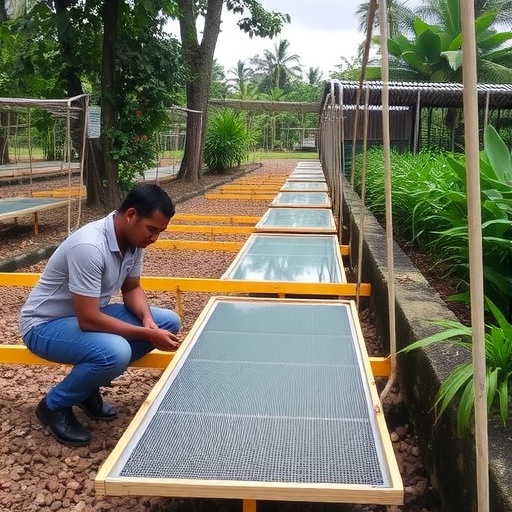In an era where climate change remains one of the most pressing issues threatening global ecosystems and economies, novel technologies aimed at carbon emission reduction have become crucial. Among these technological advancements, membrane technology stands prominently, particularly in relation to its application in carbon capture and sequestration. Research led by scientists Raynaldi and Harangozo specifically explores the cost-effectiveness of this technology in the context of Indonesia, a nation grappling with rising carbon emissions due to rapid industrialization and urbanization. Their findings present not only a scientific breakthrough but also a potential roadmap for Indonesia’s sustainable development.
The urgency to address carbon emissions in Indonesia cannot be overstated. As the fourth-largest country by population, Indonesia’s carbon output has surged in recent years, primarily from sectors like agriculture, coal-based energy, and deforestation for palm oil plantations. The need for effective carbon reduction strategies has become paramount as the country seeks to balance economic growth with sustainability. Membrane technology, characterized by its ability to selectively separate gases, emerges as a viable solution in this landscape.
Raynaldi and Harangozo’s research delves into the intricate mechanisms of membrane technology, elucidating its operational principles that enable the separation of carbon dioxide from other gases. Membranes work by exploiting differences in molecular size and permeability, allowing for efficient carbon capture without requiring extensive infrastructure alterations. This characteristic attributes to the flexibility of membrane systems, making them ideal candidates for integration into existing industrial processes across various sectors.
One of the remarkable aspects of their study is the financial analysis incorporated into the examination of membrane technology. By assessing both the costs and benefits associated with implementation, the researchers provide a comprehensive overview of the economic viability of this carbon reduction method. Initial investments in membrane technology could be substantial; however, the long-term benefits, including reduced carbon taxes and improved air quality, present a compelling argument for stakeholders concerned about environmental impact.
The research highlights the potential for significant cost savings in the long run, driven by the operational efficiency of membrane systems. As they address labor and energy expenses, these systems can deliver competitive advantages for firms committed to sustainability. Furthermore, it can reduce their reliance on traditional carbon capture methods, which often involve chemical processes that can be labor-intensive and costly.
Additionally, the study outlines the crucial role that government policies play in facilitating the adoption of membrane technology. Indonesia’s commitment to the Paris Agreement brings forth obligations to reduce national carbon emissions, representing both a challenge and an opportunity for industries. The implementation of supportive regulatory frameworks can foster innovation, encouraging companies to invest in cleaner technologies and thus advance environmental goals.
Raynaldi and Harangozo also examine the environmental ramifications of adopting membrane technology in Indonesia. Historically, the country has faced criticisms for its environmental practices, particularly in relation to deforestation and land-use changes. Integrating carbon capture technologies into industrial practices represents a significant stride toward reducing greenhouse gas emissions, aligning with Indonesia’s broader environmental restoration initiatives.
Moreover, the researchers discuss the importance of public perception and acceptance of new technologies. Community engagement and awareness are essential components in successfully deploying membrane technology in Indonesia. By educating local populations about the benefits of carbon capture, the industry can garner support for these initiatives, ultimately leading to higher adoption rates and more robust accountability mechanisms.
The implications of their research extend beyond Indonesia—it serves as a model for other developing nations grappling with similar environmental challenges. The adaptability of membrane technology opens doors for various applications, from power generation to manufacturing, encouraging a global discourse on sustainable practices that can be tailored to individual national contexts.
As organizations around the world strive to meet their carbon neutrality goals, the role of technological innovation becomes increasingly significant. Researchers like Raynaldi and Harangozo pave the way for a more sustainable future. Their findings underscore the interconnectedness of science, economics, and policy in the fight against climate change. By demonstrating that decreased carbon emissions can align with economic interests, their work offers a hopeful perspective on achieving a greener planet.
The study also opens avenues for future research, inviting further investigations into optimizing membrane technology. Future studies could focus on enhancing membrane materials, improving durability, and expanding the operational scope of these systems. Furthermore, research into hybrid systems that integrate membrane technology with other carbon management practices could yield even greater efficiencies in emission reductions.
In conclusion, the findings of Raynaldi and Harangozo spearhead an urgent conversation about sustainable practices in Indonesia, casting a spotlight on membrane technology’s transformative potential. Their work encapsulates a proactive approach to addressing climate change while deliberating on the delicate balance between economic growth and environmental stewardship. The path forward will require collaboration across various sectors—government, industry, and civil society—to ensure that the promising technology can be harnessed effectively for carbon emission reduction. This collective effort will be vital in combating climate change and shaping a sustainable future for generations to come.
Subject of Research: Cost–benefit evaluation of membrane technology for carbon emission reduction in Indonesia
Article Title: Cost–benefit evaluation of membrane technology for carbon emission reduction in Indonesia
Article References:
Raynaldi, M., Harangozo, G. Cost–benefit evaluation of membrane technology for carbon emission reduction in Indonesia.
Discov Sustain 6, 1046 (2025). https://doi.org/10.1007/s43621-025-01879-2
Image Credits: AI Generated
DOI: 10.1007/s43621-025-01879-2
Keywords: Carbon emissions, membrane technology, cost-benefit analysis, Indonesia, sustainability, environmental impact, carbon capture technologies.




